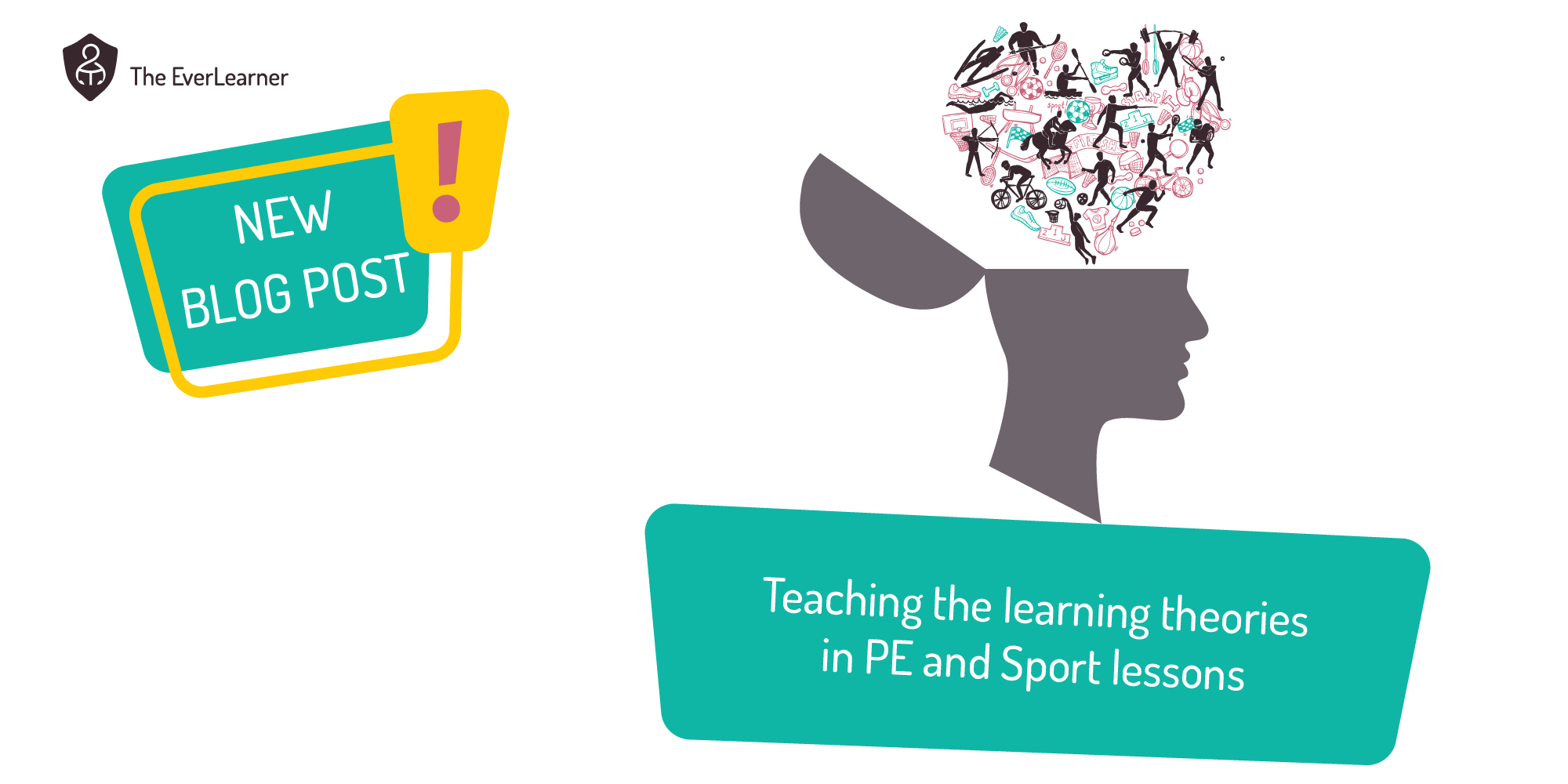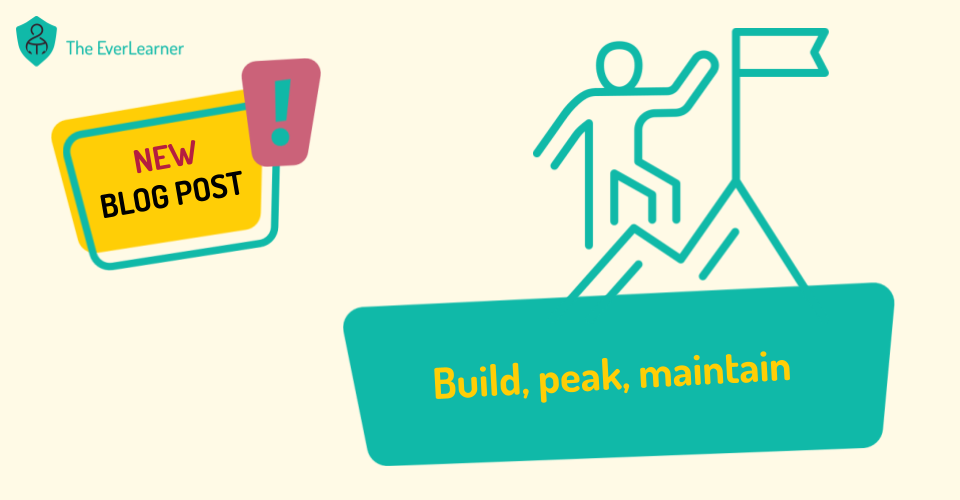Flipped Learning within your PE Theory Course
Welcome to my blog. I write every week about the teaching of PE with a specialist focus on teaching qualification PE.
In this week’s blog, I want to address some ideas I have regarding the usage of my learning platform, TheEverLearner.com, by PE teachers and provide some really tangible options that PE teachers can consider for increasing the impact of their usage.
Teachers ask me this question all the time:
Whenever this question is posed, I make reference to three mechanisms that teachers use:
- Reactivation of learning (often through a homework strategy)
- Flipped learning
- Blended learning
Each model has its strengths and weaknesses and all of them can be used in unison but, for the purposes of clarity, I am going to separate each one and write a blog post about each. In today’s post, I want to share my thoughts regarding flipped learning.
Let’s start here. My definition of flipped learning is as follows:
✱The peak learning experience occurs in the presence of an educator.
If you Google “define flipped learning” you will find other definitions. For example, the Flipped Learning Network (FLN) defines it as:
“A pedagogical approach in which direct instruction moves from the group learning space to the individual learning space, and the resulting group space is transformed into a dynamic, interactive learning environment where the educator guides students as they apply concepts and engage creatively in the subject matter.”
Flipped Learning Network (FLN). (2014) What Is Flipped Learning?. Available at: https://flippedlearning.org/wp-content/uploads/2016/07/FLIP_handout_FNL_Web.pdf (Accessed: 8th November 2023).
I disagree with many features of this definition. Unfortunately, I find it aloof and many of the adjectives such as “dynamic”, “interactive” and “creative” bring me back to questionable CPD experiences in schools where people who train you seem to have little connection with an actual classroom. In my opinion, it seems to be trying way, way too hard and causes flipped learning to seem mystical and contrived.
Flipped learning is a super simple concept if it is structured with core experiences in mind. My definition of flipped learning (“The acquisition of the most relevant knowledge and skills prior to the peak learning experience which occurs in the presence of an educator”) is designed to be simple and to allow flexibility and control to be maintained by the educator.
What are the core pillars of flipped learning?
We know that flipped learning involves episodes of learning both in and out of the presence of an educator. We also know that the acquisition – we’ll come back to this word – of the most relevant knowledge and skills occurs first or prior to the peak learning experience. For these reasons, we need to structure the pillars and expectations of this process.
| Pillar zero | (Almost always overlooked) The pre-learning material needs to be an exact and specific piece of instruction designed for the purpose and the specific course being studied. |
| Pillar one | The pre-learned material (often in video format) needs to be educationally tracked. |
| Pillar two | The pre-learned material needs to deliver both the core concepts and the key skills related to this concept. |
| Pillar three | The pre-learned material must be subject to a simple assessment prior to the peak learning experience (the lesson). |
| Pillar four | The pre-assessment must be repeatable and demand a mastery standard. |
| Pillar five | The pre-assessment must be unique for every iteration. |
| Pillar six | The educator must be aware of the pre-learned performances prior to the peak learning experience. |
This above 👆👆👆👆 is what flipped learning MUST be in order to cause learning and appropriate structures in the peak learning experience (lesson). This is what we must do in order to make flipped learning impactful in schools and colleges.
How is this achieved?
I am going to provide you with an insight into my mechanisms for flipped learning with my groups. I should be clear that I have been working, to a greater and lesser extent, with a flipped learning model for approximately 12 years and, specifically, with the teaching of qualification PE courses. This is how I do it:
Let’s assume that my lesson is on a Friday at 10:00. This makes Friday 10:00 the “peak learning experience” of the concept and skills in question. Let’s also assume that the peak learning experience relates to the components of fitness and that, during the lesson on Friday, I intend to work with the students on justifying and evaluating skills (note that, unlike the FLN, I am not claiming creativity, dynamism or any other unrealistic goal. No: I simply want my students to learn well).
Here is what I will expect my students to do prior to the Friday lesson:
Pre-loading Task 1 - Study
In this task, I expect my students to study 100% of my educationally tracked tutorial prior to the lesson on Friday. Below, you can see the assignment I have set:
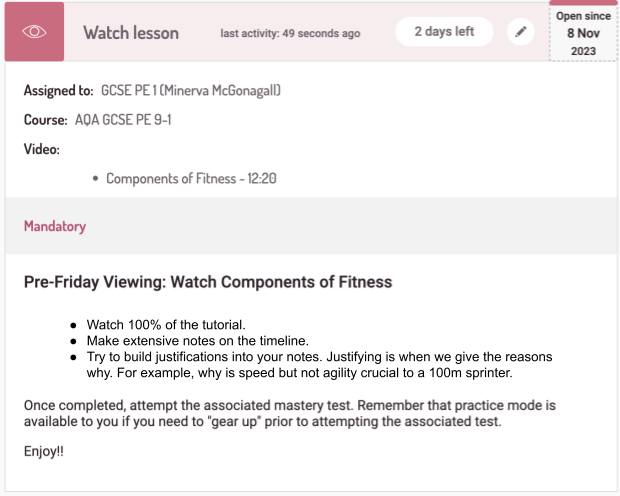
And you can also see the features of the video player that make it educationally tracked:
![]()
Pre-loading Task 2 - Mastery of studied material
Once the student has watched the tutorials and made their notes, they are expected to master (I typically choose between 80% and 90% performance) a short test quiz which can be repeated any number of times in order to reach mastery. Remember, every iteration contains a different mix of questions.
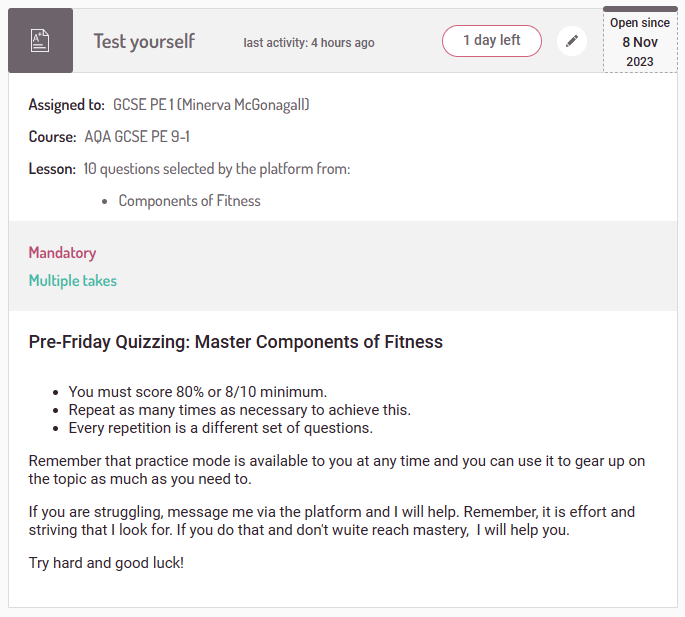
Notice the mastery standard. Notice the repeatability. Notice the clear request for effort first, which will lead to performance and support second. Notice the simplicity of both tasks. They take seconds for the teacher to set and have hyper-clear expectations for students.
The lesson/peak learning experience
Based on the pre-study my students will have done, I will target more critical skills in my lesson. I will also do this in the context of knowing how this topic is typically assessed. For example:
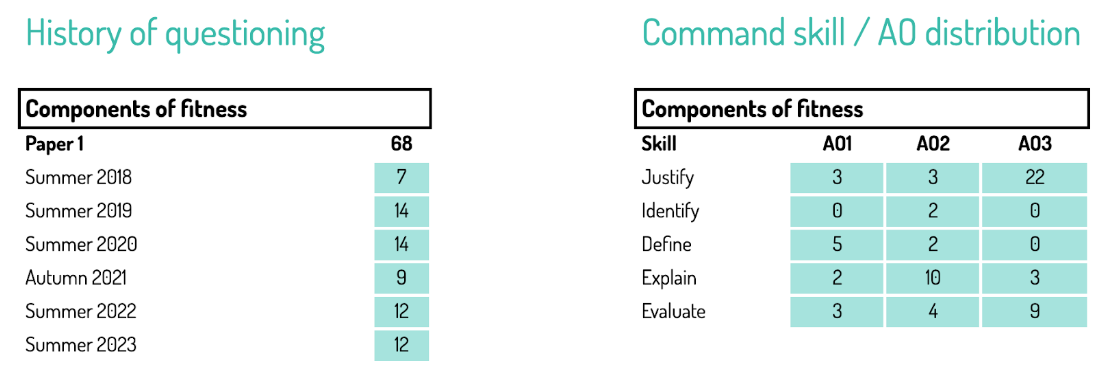
Look at the importance of the “Justify” and “Evaluate” skills. Look at the importance of both AO2 and AO3. Can there be any doubt that my lesson(s) – I am likely to do multiple lessons on this topic due to its importance – needs to be about these skills? Can there be any doubt that my students will benefit from my lesson(s) by pre-learning this material? Is there any doubt that my time as the educator is best spent developing the “Justify” and “Evaluate” skills, not just the skill of defining, say?
I also want you to notice that I am not describing mysticism here. I am describing a real application of real educational principles with real assessments in mind. If creativity occurs, it is a by-product of a robust educational structure. If a visitor were to perceive “dynamic learning” in my classroom, this would be accidental and secondary because the aim is learning. Learning really, really deeply.
This is real flipped learning in my classroom. I hope it may be relevant to you.
Thank you for reading.
%20Text%20(Violet).png)

